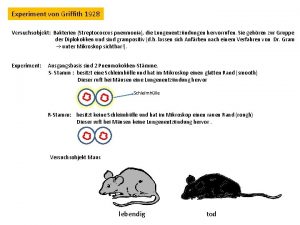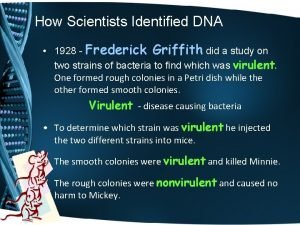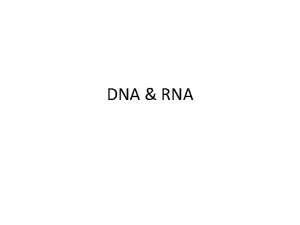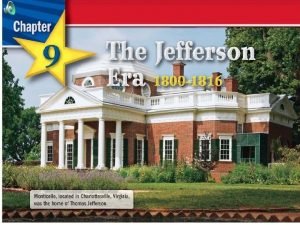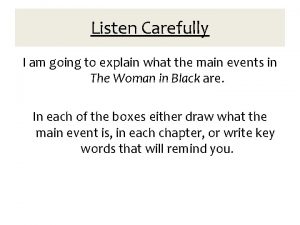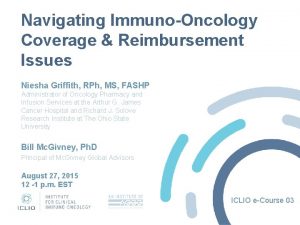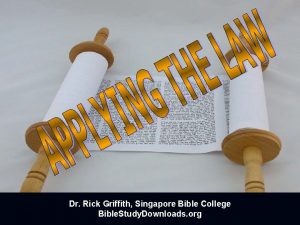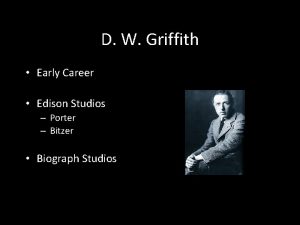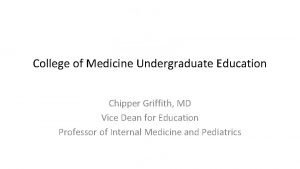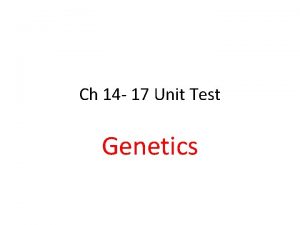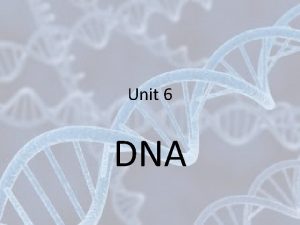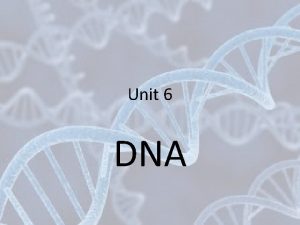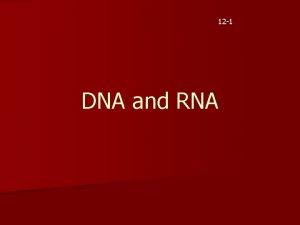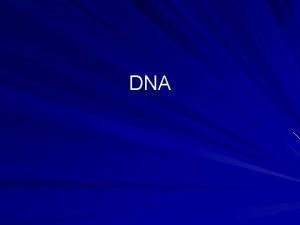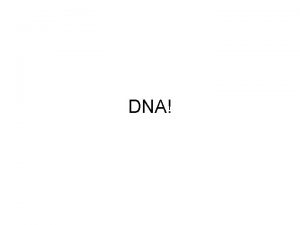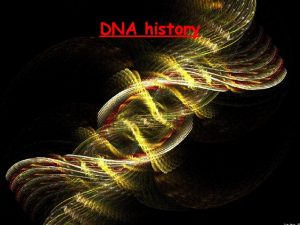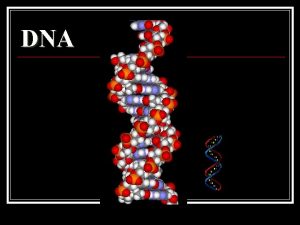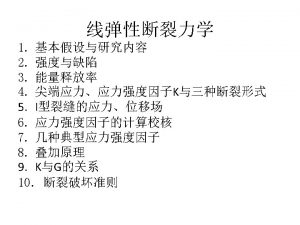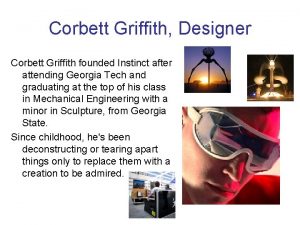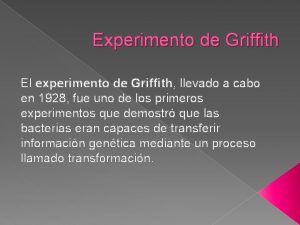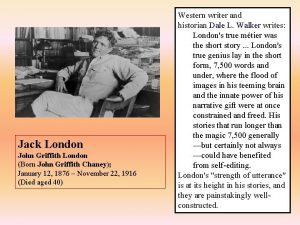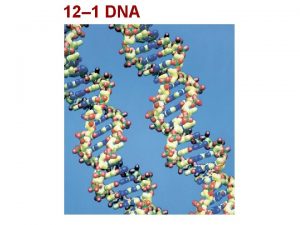The History of DNA 1 Griffith experiment showed






















- Slides: 22

The History of DNA

1. Griffith- experiment showed that live uncoated bacteria acquired the ability to make coats from dead coated bacteria. He called the process transformation. The study suggested that DNA was the genetic material.

Figure 12– 2 Griffith’s Experiment Section 12 -1 Heat-killed, diseasecausing bacteria (smooth colonies) Disease-causing bacteria (smooth colonies) Dies of pneumonia Go to Section: Harmless bacteria Heat-killed, disease(rough colonies) causing bacteria (smooth colonies) Lives Control (no growth) Live, disease-causing bacteria (smooth colonies) Harmless bacteria (rough colonies) Dies of pneumonia

Experiments Frederick Griffith • Smooth bacteria → mouse = dies of pneumonia • Rough bacteria → mouse = lives • Heat-killed smooth bacteria + Live rough bacteria → mouse = dies of pneumonia

Experiments Oswald Avery • Question: Which molecule caused the transformation of rough to smooth bacteria? • Avery extracted the heat killed bacteria and mixed them with macromolecules 1. Lipids 2. Proteins 3. nucleic acids 4. carbohydrates • He exposed the rough cells to the macromolecules one at a time and each time no transformation occurred, except when exposed to the nucleic acid DNA.

2. Avery- discovered that DNA is the nucleic acid that stores and transmits the genetic information from one generation to the next. 3. Hershey & Chase- used radioactive labeling to identify DNA. They showed that DNA, not protein, is the genetic material of a bacteriophage (virus).

The Hershey-Chase Experiment Alfred Hershey & Martha Chase worked with a bacteriophage: A virus that invades bacteria. It consists of a DNA core and a protein coat Protein coat DNA


4. Erwin Chargaff showed the amounts of the 4 bases on DNA 1950 Erwin Chargaff’s Rule: Equal amounts of Adenine and Thymine, and equal amounts of Guanine and Cytosine

5. Rosalind Franklin took x-ray diffraction photographs of DNA X-Ray diffraction image of DNA taken by Franklin in 1951 Rosalind Franklin

6. Watson and Crick built the first model of DNA using Franklin’s x-rays The 3 -D model was called a double helix James Watson Francis Crick


DNA Structure • DNA is made up of monomers called nucleotides. • A Nucleotide consists of : – 5 carbon sugar called deoxyribose – Phosphate group – Nitrogen base

• DNA is like a ladder that has been twisted to form a double helix. • The sugar and phosphate groups alternate and make up the sides of the DNA ladder.

• The nitrogen bases make up the rungs of the DNA ladder. The nitrogen bases are: – Adenine – Guanine – Cytosine – Thymine • The bases are held together by weak hydrogen bonds

• Purines have a double ring structure • Pyrimidines have a single ring structure • A Purine will always pair with a Pyrimidine


DNA Replication 1. Before a cell divides DNA is copied (replicated) during Synthesis of Interphase 2. During DNA replication, the DNA molecule separates into 2 strands. Each new strand will hook up with it’s complementary base partner, making 2 new complementary strands.

The strands follow Chargaff’s rule on base pairing. 3. The sites where separation and replication occur are called replication forks. 4. The replication is carried out by enzymes that “unzip” the DNA called helicases.

5. DNA polymerases are enzymes that create DNA molecules by assembling nucleotides, the building blocks of DNA. These enzymes are essential to DNA replication and usually work in pairs to create two identical DNA strands from a single original DNA molecule.


DNA to Chromosome DNA coils around histones to form nucleosomes, which coil to form chromatin fibers. The chromatin fibers super coil to form chromosomes that are visible in the metaphase stage of mitosis
 Versuch griffith
Versuch griffith 1928 griffith
1928 griffith Dna and rna structure
Dna and rna structure Dna polymerase function in dna replication
Dna polymerase function in dna replication Bioflix activity dna replication lagging strand synthesis
Bioflix activity dna replication lagging strand synthesis Coding dna and non coding dna
Coding dna and non coding dna What are the enzymes involved in dna replication
What are the enzymes involved in dna replication Dna rna protein synthesis homework #2 dna replication
Dna rna protein synthesis homework #2 dna replication What lessons did the skunk teach brian
What lessons did the skunk teach brian The election of 1800 showed that
The election of 1800 showed that A tv reporter showed this graph and said
A tv reporter showed this graph and said Nethinim
Nethinim Sally showed absolutely no fear when climbing the wall
Sally showed absolutely no fear when climbing the wall Dr rick griffith
Dr rick griffith Vandewalles appleton
Vandewalles appleton Niesha griffith
Niesha griffith Griffith thomas
Griffith thomas Dr rick griffith
Dr rick griffith Monomer of dna
Monomer of dna Melanie griffith
Melanie griffith Dw griffith
Dw griffith Dr rick griffith
Dr rick griffith In his transformation experiments what did griffith observe
In his transformation experiments what did griffith observe
